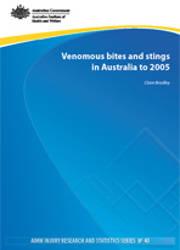Table of contents
- Preliminary material
- Title and verso pages
- Contents
- Acknowledgements
- Executive summary
- Types of venomous bite and sting cases 2002-05
- Factors associated with bite and sting cases 2002-05
- Trends in hospitalised bites and stings 1999-05
- Types of venomous bite and sting cases 2002-05
- Body section
- Introduction
- 1.1 Venomous bites and stings 2002-05
- 1.1.1 Age and sex distribution
- 1.1.2 Cases by state of usual residence
- 1.1.3 Cases by remoteness of usual residence
- 1.1.4 Types of bite and sting cases
- 1.1.5 Principal diagnosis for bite and sting cases
- 1.1.6 Procedures listed for bite and sting cases
- 1.1.7 Place of occurrence for bite and sting cases
- 1.1.8 Activity for bite and sting cases
- 1.1.9 Length of stay for bite and sting cases
- 1.1.10 Mode of separation for incident cases
- 1.2 Hospitalised bite and sting trends 1999-05
- 1.2.1 State and territory trends
- 1.2.2 Remoteness trends
- 1.1 Venomous bites and stings 2002-05
- Snakes
- 2.1 Cases by type of snake, 2002-05
- 2.2 Principal diagnosis for snakebites
- 2.3 Place and activity for snakebites
- 2.4 Length of stay for snakebite cases
- 2.5 Trends in rates of hospitalised snakebites
- Spiders
- 3.1 Cases by type of spider
- 3.2 Principal diagnosis for spider bites
- 3.3 Place and activity for spider bites
- 3.4 Length of stay for spider bites
- 3.5 Trends in rates of hospitalised spider bites
- Wasps and bees
- 4.1 Cases attributed to wasps
- 4.1.1 Place and activity for wasp stings
- 4.1.2 Principal diagnosis for wasp stings
- 4.1.3 Cases by type of wasp, 2004-05
- 4.1.4 Length of stay for wasp stings
- 4.2 Cases attributed to bees
- 4.2.1 Place and activity for bee stings
- 4.2.2 Principal diagnosis for bee stings
- 4.2.3 Cases by type of bee, 2004-05
- 4.2.4 Length of stay for bee stings
- 4.3 Trends in rates of hospitalised wasp and beestings
- 4.1 Cases attributed to wasps
- Ants and other arthropods
- 5.1 Contact with venomous ants
- 5.1.1 Cases by type of ants
- 5.1.2 Principal diagnosis for ant stings
- 5.1.3 Place and activity for ant sting cases
- 5.1.4 Length of stay for ant sting cases
- 5.2 Contact with venomous ticks
- 5.2.1 Principal diagnosis for tick bites
- 5.3 Trends in rates of hospitalised cases due to ants and other arthropods
- 5.1 Contact with venomous ants
- Marine animals and plants
- 6.1 Types of venomous marine bites and stings
- 6.2 Principal diagnosis for marine bites and stings
- 6.3 Place and activity for marine bites and stings
- 6.4 Length of stay for marine bites and stings
- 6.5 Trends in rates of hospitalised marine bites and stings
- Other venomous animals and plants (X22, X24, X27, X28 or X29)
- 7.1 Cases attributed to other venomous animals and plants, 2002-05
- 7.2 Trends in rates of hospitalised cases attributed to other venomous animals and plants
- Discussion
- 8.1 Types of hospitalised bites and stings
- 8.2 The circumstances of venomous bites and stings
- 8.3 Trends in bites and stings over time
- Data issues
- Data sources
- Selection criteria
- Rate calculation
- Small case count issues
- References
- Introduction
- End matter
- List of tables
- List of figures



